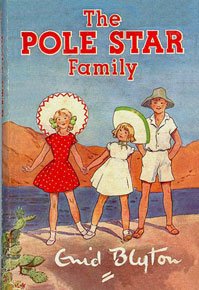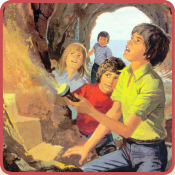
The Pole Star Family

Book Details...
First edition: 1950
Publisher: Lutterworth Press
Illustrator: Ruth Gervis
Category: Caravan Family
Genre: Family
Type: Novels/Novelettes
Publisher: Lutterworth Press
Illustrator: Ruth Gervis
Category: Caravan Family
Genre: Family
Type: Novels/Novelettes
On This Page...
Reprints
1. 1985 Sparrow, illustrations and cover by David Dowland
2. 1989 Beaver, illustrations by David Dowland, cover uncredited
3. 1997 Mammoth, illustrations by Ruth Gervis, cover by Richard Jones
2. 1989 Beaver, illustrations by David Dowland, cover uncredited
3. 1997 Mammoth, illustrations by Ruth Gervis, cover by Richard Jones

Wraparound dustwrapper from the 1st edition, November 1950 @ 4/-, illustrated by Ruth Gervis

Frontis from the 1st edition, illustrated by Ruth Gervis
The trip the family take is the exact trip Enid experienced in the early thirties with Hugh; the trip that also served for The Ship of Adventure cruise, incidentally written in the same year as The Pole Star Family. The real strength of this book, like the Adventure book, is the fact that the cruise is a real one, and Enid's descriptions bear this out, for they help the story immensely. Even the children's ship, the Pole Star is not so very far removed, in title, (only five letters in fact) from the ship Enid herself travelled on, which was called the Stella Polaris.
The family travel from Southampton to Portugal, Spain, Madeira, the Canaries and Morocco. They watch flying fish sail past their ship, swim in the pool, experience rough times in the Bay of Biscay and again witness a holiday that most children of the era would never have experienced. Enid fills the book, once again, with a marvellous atmosphere, describing how they pass the Isle of Wight on one side and the mainland on the other, and introducing the subject of a later book in the series, The Queen Elizabeth Family, which the children see waiting in dock. The sight of this ship brings a lump to Mikes throat as he gazes upon it for the first time; 'he felt very proud of that beautiful British ship.'
One gets the feeling from reading The Pole Star Family that most of the things that happen were also experienced by Enid when she took the same voyage in 1930. Mummy and Daddy dress for dinner, and it is easy to imagine Enid and Hugh doing the same and looking similarly 'very grand' as Enid describes it. Indeed, one of the most satisfying aspects of this particular novel is the realisation, always at the back of the readers mind, that we are actually experiencing the voyage through Enid's eyes exactly as she saw it. It is a well-known fact that Enid rarely wasted her real-life experiences, and it is very clear that much of what she describes is a very personal account of her holiday all those years before. Because of this, the book takes on a very personal quality and actually tells us a great deal about Enid as a person. The book really seems to 'show the author' in its telling.
The descriptions of the ensuing voyage and the sights the family encounter are extremely close in flavour (and effectiveness) to those in The Ship of Adventure. As I have already mentioned in my article about the adventure series, I felt that the voyage in 'Ship' was actually more entertaining than the adventure, and it seems that Enid had also noted the strengths of this particular story, for she repeats much of it here, this time making it the main core of the novel. We sail with the family to Casablanca, which as before is dirty and smelly, everything and everybody covered in flies. Ann, like Mrs. Mannering and Enid before her, has to use smelling salts to stop herself from being sick. Once again this is a brilliant bit of descriptive writing, Enid managing to sum up the sights and sounds of Casablanca with only a few short sentences, with the descriptions of the dirty streets, the 'queer little shops' selling 'rings and bracelets, beautiful pottery, queer slippers...bags, baskets, brass pots...' and of a 'darling little baby' with 'flies crawling all round its poor eyes!' — sights that no doubt Enid experienced for herself and was never to forget.
The storm scenes which accompany the families homeward journey are exceptionally good, as they were in The Ship of Adventure, Enid even giving us such details as to the 'fiddles' fitted onto the tables to stop the plates from sliding off, suitcases sliding up and down the floor of the children's cabin and of trying to eat and drink 'without spilling anything'. On top of this, Gervis's wonderful illustration of the children standing on a sea-soaked deck in their raincoats watching the storm helps brilliantly in conjuring up the wet, salty atmosphere Enid describes.
The book concludes with the family gratefully making their way home to England, Enid relishing the first distant glimpses of home just as much as her characters do. Once again it is clear from the descriptions just how Enid had felt after her cruise; 'He had a queer lump in his throat as he watched the faint line grow bigger and stronger. He seemed to know and love his own country much more now that he had been to others. He would always, always love it best!'
Mummy has similar feelings, squeezing Daddy's hand and saying; 'Home's all the nicer for having being away from it, isn't it? ...Dear old England! We're coming back to your autumn mists, your yellowing trees and falling leaves — and we're glad!'
Altogether, like the books that proceeded it, The Pole Star Family is a very satisfying read (when viewed at is own level, of course) and has much to recommend it, not least its main strength; that it was essentially a 'real-life' re-telling of Enid's own holiday cruise of the early 30s. These illustrations are hidden by default to ensure faster browsing. Loading the illustrations is recommended for high-speed internet users only.








